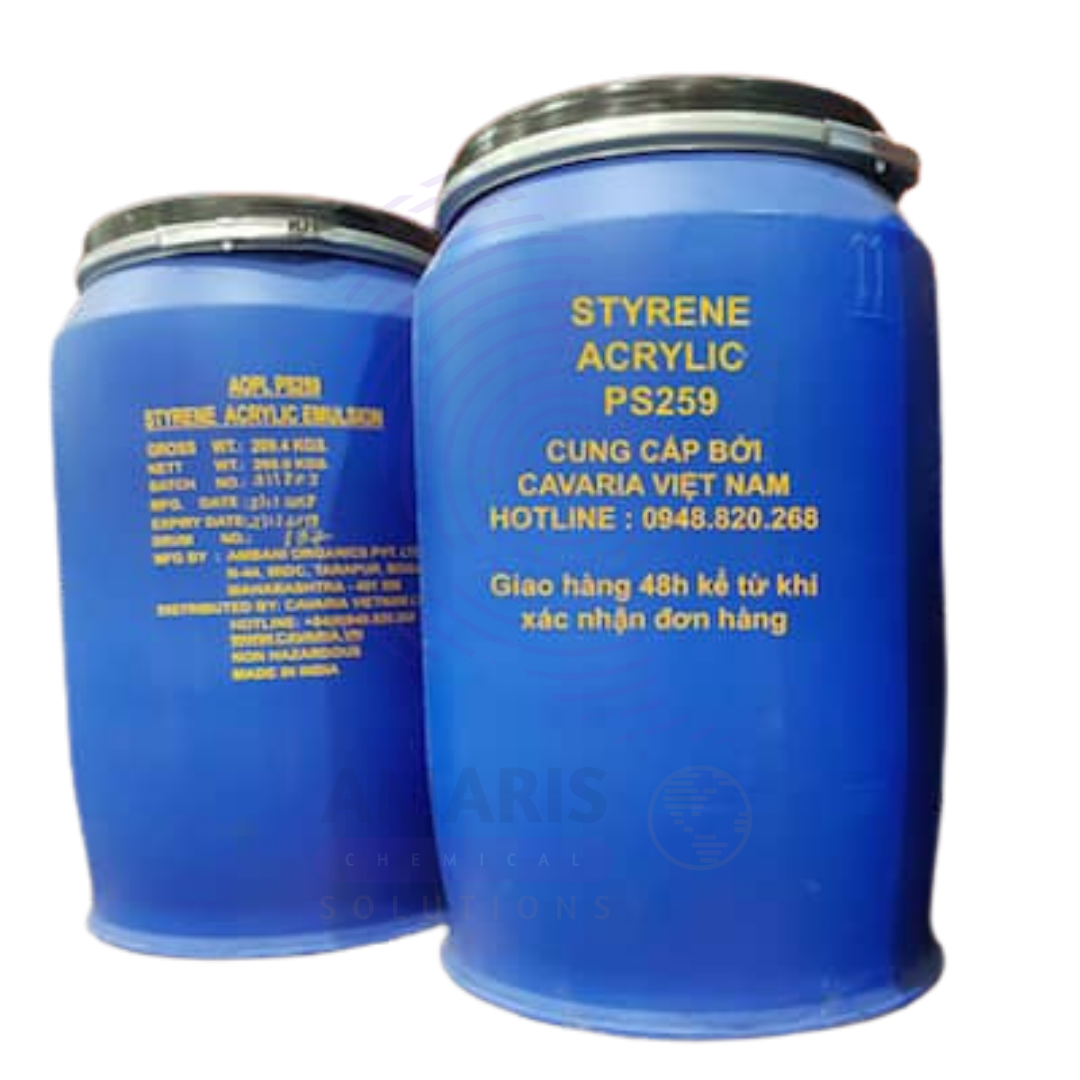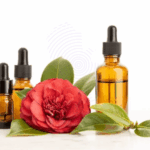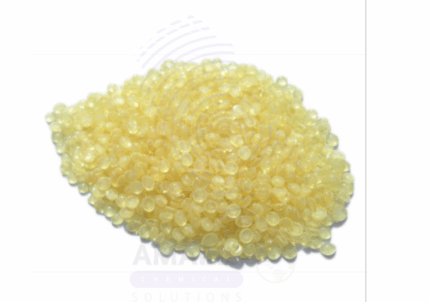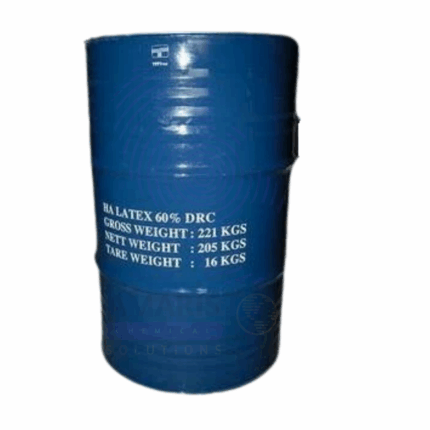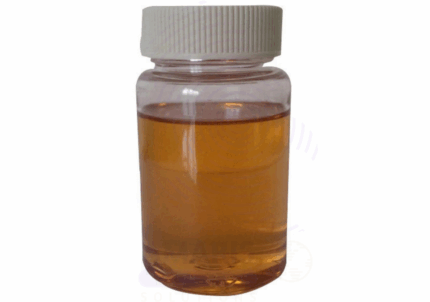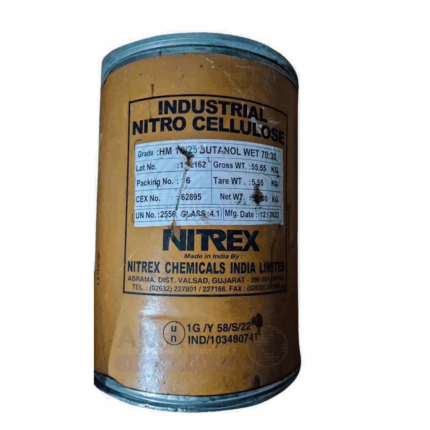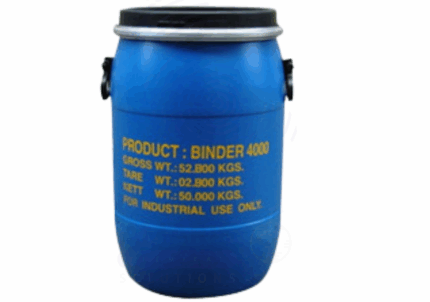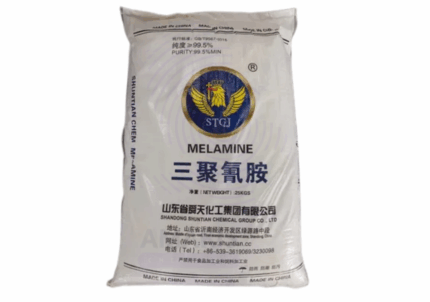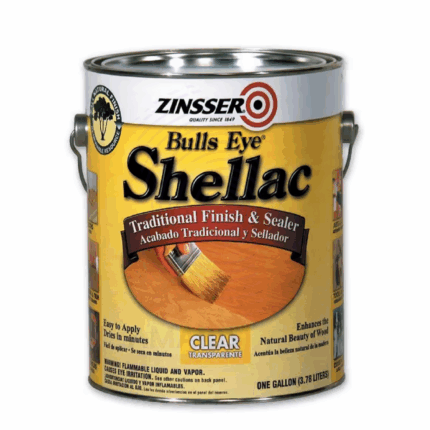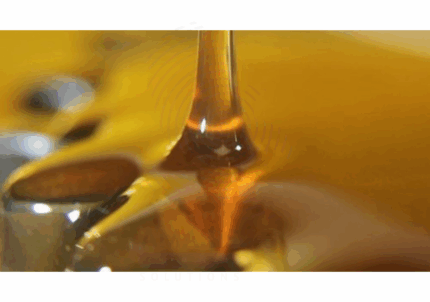Back to products
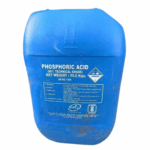

Phosphoric acid Technical Grade
$ 3.12 Original price was: $ 3.12.$ 3.10Current price is: $ 3.10.
Styrene Acrylic
Whatsapp Order
Styrene Acrylic is a copolymer emulsion combining styrene and acrylic monomers, widely used as a versatile binder in coatings, adhesives, and construction materials. It offers excellent film-forming properties, adhesion, water resistance, and durability. This product enhances the performance and longevity of paints, sealants, textiles, and paper coatings, with flexibility for both indoor and outdoor applications. Styrene Acrylic emulsions are designed to meet stringent industrial and environmental standards.
Description
Table of Contents
Toggle
Styrene Acrylic
Primary Uses
- Coatings & Paints Industry
- Binder in Architectural Paints: Provides excellent adhesion, gloss, and durability to interior and exterior paints.
- Protective Coatings: Used in industrial coatings for corrosion resistance and weatherproofing.
- Textile Coatings: Enhances fabric hand, durability, and resistance to water and stains.
- Paper Coatings: Improves printability, gloss, and surface strength of coated papers.
- Adhesives Industry
- Pressure-sensitive Adhesives: Used in tapes and labels for strong bonding and flexibility.
- Construction Adhesives: Provides water resistance and durability for bonding building materials.
- Packaging Adhesives: Used for flexible and rigid packaging applications requiring quick set and strong adhesion.
- Construction Industry
- Mortar and Cement Modifiers: Improves flexibility, adhesion, and water resistance in tile adhesives, cementitious coatings, and grouts.
- Sealants and Caulks: Enhances elasticity and weather resistance in silicone and acrylic sealants.
Secondary Uses
- Textiles Industry
- Fabric Finishing Agent: Provides softness, stiffness, or water repellency depending on formulation.
- Nonwoven Binders: Used in nonwoven fabric production to improve strength and durability.
- Paper Industry
- Surface Sizing Agent: Enhances ink holdout and reduces absorbency in specialty papers.
- Wet Strength Additive: Improves paper resistance to moisture.
- Leather Industry
- Coating Agent: Used to provide protective films on leather products enhancing durability and appearance.
- Plastic & Rubber Industry
- Modifier for Plastics: Improves impact resistance and flexibility in PVC and other polymers.
- Adhesion Promoter: Enhances bonding between dissimilar materials in composites.
- Printing Industry
- Ink Binder: Acts as a binder in water-based inks to improve adhesion and gloss.
KEY PRODUCT FEATURES
1. Basic Identification Attributes
- Chemical Name (IUPAC): Copolymer of styrene and acrylic monomers
- Common/Trade Name: Styrene Acrylic Emulsion
- CAS Number: Not assigned to copolymer (styrene: 100-42-5; acrylic monomers vary)
- HS Code: 3906.90.00
- Synonyms: Styrene-acrylic copolymer, Styrene acrylic resin
2. Physical & Chemical Properties
- Physical State: Milky white liquid emulsion
- Color & Odor: White; mild odor
- Solubility: Dispersible in water; insoluble in organic solvents
- pH: 7.0 – 9.0 (typically neutral to slightly alkaline)
- Solid Content: 40-55% (varies by grade)
- Viscosity: Low to medium (depending on formulation)
- Density: Approx. 1.0 – 1.1 g/cm³
3. Safety & Hazard Attributes
- GHS Classification: Not classified as hazardous
- Toxicity: Low toxicity under normal handling conditions
- Exposure Limits: No specific occupational exposure limits; follow standard chemical safety practices
4. Storage & Handling Attributes
- Storage Conditions: Store in sealed containers at 5-35 °C; protect from freezing and direct sunlight
- Container Type: Plastic drums, totes, or bulk containers
- Shelf Life: 6-12 months depending on storage conditions
- Handling Precautions: Avoid freezing, contamination, and prolonged skin contact
5. Regulatory & Compliance Attributes
- Manufactured under Good Manufacturing Practices (GMP)
- Complies with relevant REACH, TSCA, and OSHA HCS regulations
- Suitable for use in formulations compliant with VOC limits for paints and coatings
- Meets environmental standards for low volatile organic compounds emissions
6. Environmental & Health Impact
- Biodegradability: Partially biodegradable under aerobic conditions
- Ecotoxicity: Low toxicity to aquatic organisms
- Bioaccumulation: Not significant
- Environmental Notes: Wastewater treatment recommended to prevent polymer residue discharge
SAFETY HANDLING PRECAUTIONS
Safety Handling Precautions
- PPE Required: Gloves and eye protection recommended
- Handling Guidelines: Use adequate ventilation; avoid skin and eye contact
- Storage Measures: Keep containers tightly closed and protected from freezing
First Aid Measures
- Inhalation: Move to fresh air if irritation occurs
- Skin Contact: Wash with soap and water
- Eye Contact: Flush with water for 15 minutes; seek medical attention if irritation persists
- Ingestion: Rinse mouth; obtain medical advice if necessary
Firefighting Measures
- Fire Hazards: Combustible when dried; aqueous emulsion is not flammable
- Extinguishing Media: Water spray, foam, dry chemical, CO₂
- Hazardous Combustion Products: Carbon monoxide, carbon dioxide, and other organic combustion products
Related products
Epikote 828 (Epoxy Resin)
Epikote 828 (Epoxy Resin) is a liquid bisphenol-A-based epoxy resin with a low molecular weight. It is one of the most widely used general-purpose epoxy resins in industrial applications due to its excellent mechanical, chemical, and thermal properties. Epikote 828 cures with various hardeners, especially amines, to form thermoset polymers with outstanding adhesion, chemical resistance, and dimensional stability. The resin is typically a clear to pale yellow viscous liquid and is soluble in most organic solvents. It is primarily used in coatings, adhesives, composites, electrical encapsulation, flooring systems, and structural materials.
Latex
Latex is a natural or synthetic colloidal dispersion of polymer microparticles in an aqueous medium. Natural latex is harvested from rubber trees (Hevea brasiliensis) and appears as a milky fluid rich in rubber particles suspended in water. Synthetic latexes are produced from various monomers such as styrene-butadiene or acrylics. Latex exhibits excellent elasticity, flexibility, and adhesive properties. It is widely used in manufacturing gloves, balloons, coatings, adhesives, paints, and various molded products. Its film-forming ability, water resistance, and durability make it a versatile material across industries.
Linseed Oil Alkali Refined
Linseed Oil Alkali Refined is a vegetable oil extracted from flax seeds and then refined using alkali treatment to remove impurities, free fatty acids, and gums. This refining process enhances the oil’s stability, color, and odor, making it suitable for industrial, artistic, and manufacturing uses. It is a drying oil known for its excellent film-forming properties, quick drying time, and good adhesion to surfaces. Alkali refined linseed oil is widely used in paints, varnishes, inks, and as a raw material in chemical industries.
Nitro Cellulose
Nitro Cellulose is a highly flammable compound produced by nitrating cellulose through exposure to nitric acid and sulfuric acid. It is a versatile material widely used in coatings, lacquers, explosives, and propellants due to its film-forming properties and rapid drying capability. Nitro Cellulose is available in various grades depending on the nitrogen content and viscosity, making it suitable for industrial, commercial, and military applications.
Penetrator Binder
Penetrator Binder is a high-performance binding agent designed to improve the adhesion and penetration of coatings, adhesives, and sealants into porous substrates. It enhances substrate wettability and strengthens the bond between the applied material and the surface, resulting in improved durability and performance. Penetrator Binder is commonly used in construction, wood treatment, and industrial coatings to ensure better material integration and resistance to environmental factors.
Setamine ( Melamine Resin)
Setamine (Melamine Resin) is a thermosetting polymer widely used for its excellent hardness, chemical resistance, and thermal stability. It is produced by the reaction of melamine with formaldehyde and is commonly utilized in coatings, laminates, adhesives, and molding compounds. Setamine offers superior durability, scratch resistance, and moisture resistance, making it ideal for high-performance surface finishes and industrial applications.
Shellac
Shellac is a natural resin secreted by the lac insect, primarily found in South Asia. It is processed into flakes or powder form and dissolved in alcohol to create a versatile film-forming agent. Shellac provides excellent adhesion, gloss, and moisture resistance, making it widely used as a wood finish, food glaze, and pharmaceutical coating. It is valued for its natural origin, biodegradability, and safe use in food and cosmetic applications.
Short Oil Fast Drying (16/50) (SDA)
Short Oil Fast Drying (16/50) (SDA) Stand & Detail Alkyd (SDA) is a specially formulated alkyd resin designed for rapid drying and excellent film formation in coatings. It contains approximately 16% oil length, offering a balance between hardness and flexibility, and 50% solids content, which aids in build and coverage. This resin is widely used in industrial and decorative paints where quick drying and good adhesion are critical. Its fast curing properties make it ideal for applications requiring reduced downtime and enhanced productivity.


 Preservatives(food)
Preservatives(food) Flavor Enhancers
Flavor Enhancers Acidulants
Acidulants Sweeteners
Sweeteners Antioxidants
Antioxidants Colorants(food)
Colorants(food) Nutraceutical Ingredients (food)
Nutraceutical Ingredients (food) Nutrient Supplements
Nutrient Supplements Emulsifiers
Emulsifiers
 Collectors
Collectors Dust Suppressants
Dust Suppressants Explosives and Blasting Agents
Explosives and Blasting Agents Flocculants and Coagulants
Flocculants and Coagulants Frothers
Frothers Leaching Agents
Leaching Agents pH Modifiers
pH Modifiers Precious Metal Extraction Agents
Precious Metal Extraction Agents
 Antioxidants(plastic)
Antioxidants(plastic) Colorants (Pigments, Dyes)
Colorants (Pigments, Dyes) Fillers and Reinforcements
Fillers and Reinforcements Flame Retardants
Flame Retardants Monomers
Monomers Plasticizers
Plasticizers Polymerization Initiators
Polymerization Initiators Stabilizers (UV, Heat)
Stabilizers (UV, Heat)
 Antifoaming Agents
Antifoaming Agents Chelating Agents
Chelating Agents Coagulants and Flocculants
Coagulants and Flocculants Corrosion Inhibitors
Corrosion Inhibitors Disinfectants and Biocides
Disinfectants and Biocides Oxidizing Agents
Oxidizing Agents pH Adjusters
pH Adjusters Scale Inhibitors( water)
Scale Inhibitors( water)
 Antioxidants(cosmetic)
Antioxidants(cosmetic) Emollients
Emollients Fragrances and Essential Oils
Fragrances and Essential Oils Humectants
Humectants Preservatives
Preservatives Surfactants(cosmetic)
Surfactants(cosmetic) Thickeners
Thickeners UV Filters
UV Filters
 Fertilizers
Fertilizers Soil Conditioners
Soil Conditioners Plant Growth Regulators
Plant Growth Regulators Animal Feed Additives
Animal Feed Additives Biostimulants
Biostimulants Pesticides (Herbicides, Insecticides, Fungicides)
Pesticides (Herbicides, Insecticides, Fungicides)
 Active Pharmaceutical Ingredients (APIs)
Active Pharmaceutical Ingredients (APIs) Excipients
Excipients Solvents(pharmaceutical)
Solvents(pharmaceutical) Antibiotics
Antibiotics Antiseptics and Disinfectants
Antiseptics and Disinfectants Vaccine Adjuvants
Vaccine Adjuvants Nutraceutical Ingredients (pharmaceutical)
Nutraceutical Ingredients (pharmaceutical) Analgesics & Antipyretics
Analgesics & Antipyretics
 Analytical Reagents
Analytical Reagents Solvents(lab)
Solvents(lab) Chromatography Chemicals
Chromatography Chemicals Spectroscopy Reagents
Spectroscopy Reagents microbiology-and-cell-culture-reagents
microbiology-and-cell-culture-reagents Molecular Biology Reagents
Molecular Biology Reagents Biochemical Reagents
Biochemical Reagents Inorganic and Organic Standards
Inorganic and Organic Standards Laboratory Safety Chemicals
Laboratory Safety Chemicals Specialty Laboratory Chemicals(Special Laboratory Equipment)
Specialty Laboratory Chemicals(Special Laboratory Equipment)
 Demulsifiers
Demulsifiers Hydraulic Fracturing Fluids
Hydraulic Fracturing Fluids Scale Inhibitors(oil)
Scale Inhibitors(oil) Surfactants(oil)
Surfactants(oil) Drilling Fluids
Drilling Fluids
 Dyes and Pigments
Dyes and Pigments Bleaching Agents
Bleaching Agents Softening Agents
Softening Agents Finishing Agents
Finishing Agents Antistatic Agents
Antistatic Agents
 Admixtures
Admixtures Waterproofing Agents
Waterproofing Agents Sealants and Adhesives
Sealants and Adhesives Curing Compounds
Curing Compounds Concrete Repair Chemicals
Concrete Repair Chemicals Anti-Corrosion Coatings
Anti-Corrosion Coatings
 Surfactants(cleaning)
Surfactants(cleaning) Builders
Builders Enzymes
Enzymes Solvents (Cleaning)
Solvents (Cleaning) Fragrances
Fragrances
 Electronic Chemicals
Electronic Chemicals Catalysts
Catalysts Lubricants
Lubricants Photographic Chemicals
Photographic Chemicals Refrigerants
Refrigerants Automotive chemicals
Automotive chemicals Pyrotechnic Chemicals
Pyrotechnic Chemicals
 Biodegradable Surfactants
Biodegradable Surfactants Bio-based Solvents
Bio-based Solvents Renewable Polymers
Renewable Polymers Carbon Capture Chemicals
Carbon Capture Chemicals Wastewater Treatment Chemicals
Wastewater Treatment Chemicals
 Pigments
Pigments Solvents(paint)
Solvents(paint) Specialty Coatings
Specialty Coatings Binders/Resins
Binders/Resins Additives
Additives Driers
Driers Anti-Corrosion Agents
Anti-Corrosion Agents Functional Coatings
Functional Coatings Application-Specific Coatings
Application-Specific Coatings
 Fresh Herbs
Fresh Herbs Ground Spices
Ground Spices Whole Spices
Whole Spices Spice Blends
Spice Blends Dried Herbs
Dried Herbs
 Leavening Agents
Leavening Agents Dough Conditioners
Dough Conditioners Flour Treatments
Flour Treatments Fat Replacers
Fat Replacers Decoratives
Decoratives Preservatives(baking)
Preservatives(baking)
 Plasticizers & Softeners
Plasticizers & Softeners Reinforcing Agents
Reinforcing Agents Adhesion Promoters
Adhesion Promoters Vulcanizing Agents
Vulcanizing Agents Antidegradants
Antidegradants Blowing Agents
Blowing Agents Fillers & Extenders
Fillers & Extenders Accelerators & Retarders
Accelerators & Retarders